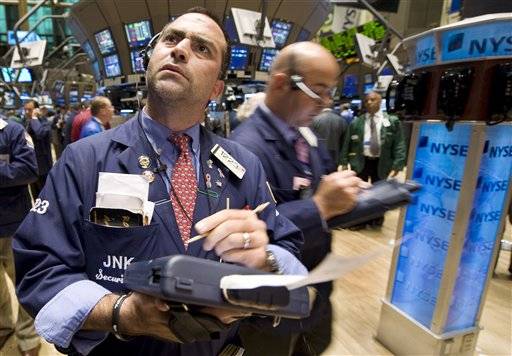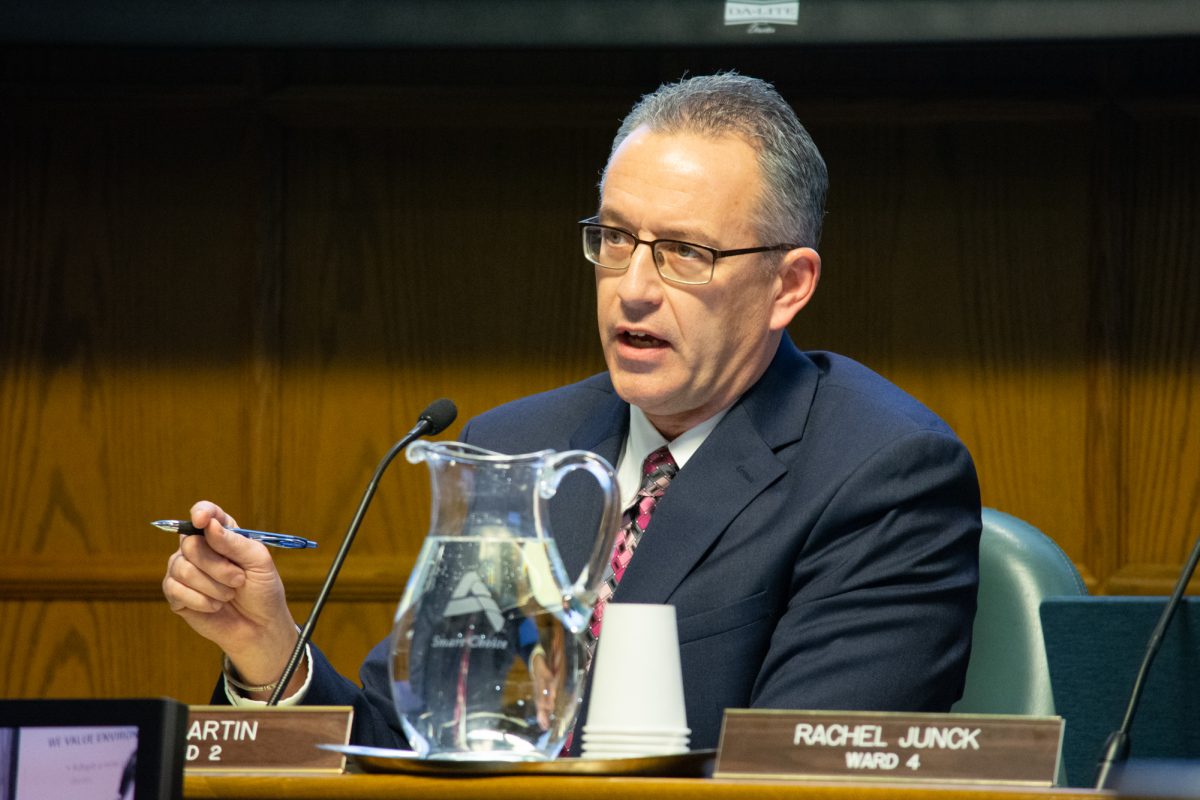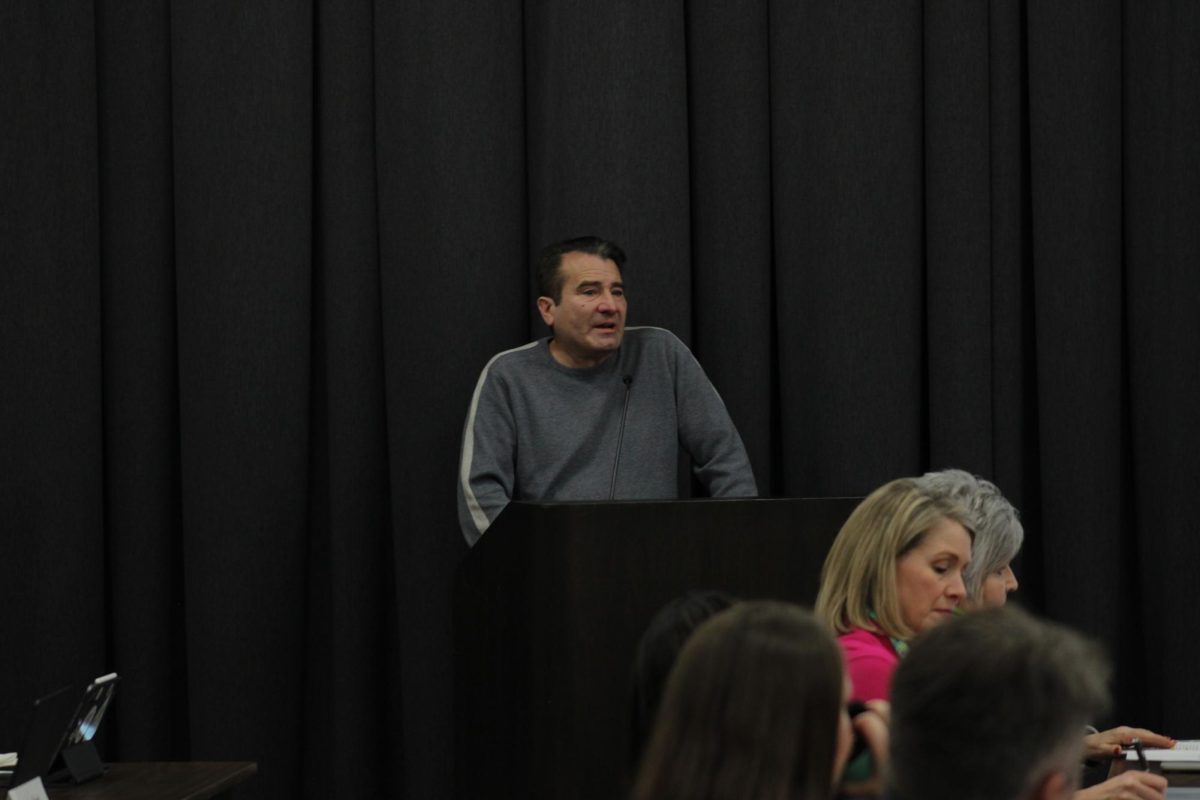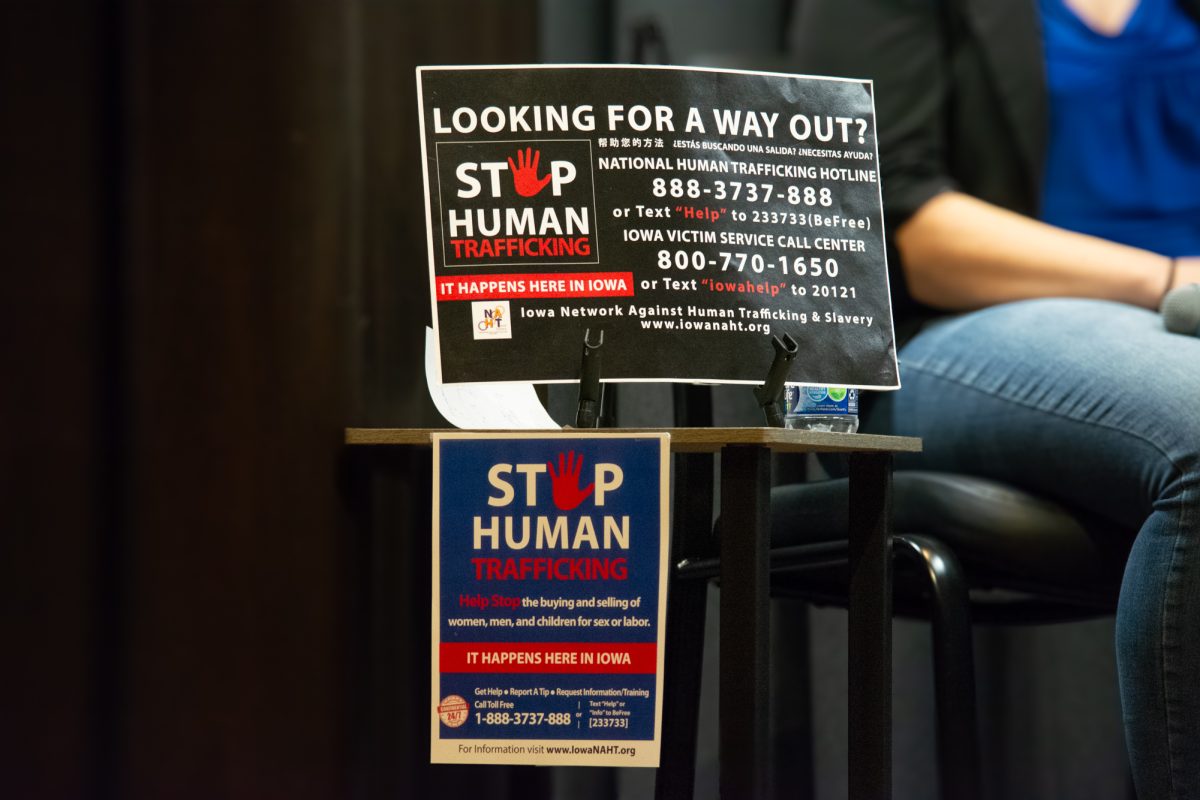Fed, central banks move to boost global confidence

Trader Joseph Acquafredda, left, checks the numbers near the close of trading on the floor of the New York Stock Exchange on Wednesday. The Dow Jones industrial average dropped 449.36 or – 4.06 percent. (AP Photo/Richard Drew)
September 17, 2008
NEW YORK (AP) — The worst global financial crisis since the Great Depression forced the Federal Reserve and central banks in other countries to pump billions of dollars into the world’s banking system in a urgent bid to stop further damage.
The Fed plowed as much as $180 billion into money markets overseas. At home, the New York Federal Reserve acted to ease a spike in overnight lending rates by injecting $55 billion into the banking system.
Wall Street initially rallied, but trimmed gains as the morning wore on.
President Bush canceled an out-of-town trip to stay in Washington and to huddle with Treasury Secretary Henry Paulson. Bush pledged to do all that was necessary to stem the crisis, whose fallout threatens the already fragile economy.
“The American people can be sure we will continue to act to strengthen and stabilize our financial markets and improve investor confidence,” Bush said.
The move by the Fed and its overseas counterparts was aimed at boosting waning confidence and getting banks around the world to open their ever-tightening purse strings. Banks have been increasingly reluctant to lend to each other as distrust spread throughout the financial system.
A sharp rise in borrowing costs has worsened as bad bets on dodgy mortgage-backed securities claimed more Wall Street giants. The total amount of commercial paper fell by $52.1 billion for the week that ended Wednesday, as banks cut back the short-term loans companies from small garment factories to General Electric Co. depend on for their daily operations. At the same time, the interest rate on those short-term loans more than doubled, with rates for seven-day paper jumping to 4.5 percent from 2.5 percent.
Asian markets closed lower, but the action by central banks helped send European stocks higher after three days of losses.
Russia closed its stock exchanges for a second day Thursday as President Dmitry Medvedev pledged a 500 billion ruble ($20 billion) injection into financial markets to stem a dizzying plummet in share prices — and quash fears of a repeat of the country’s 1998 financial collapse.
Wall Street was mixed after dropping 450 points Wednesday when a Fed bailout of American International Group Inc., one of the world’s largest insurers, failed to settle the markets’ frayed nerves.
But worries that other financial companies could fail cast a pall on the central banks’ step, which spread billions of dollars around the world in exchange for foreign currencies. Investors were still pouring into Treasury securities and gold, traditional safe-havens in times of turmoil.
The president was to meet with economic advisers over much of the day, and was seeing Treasury Secretary Henry Paulson at the White House later Thursday.
“Our financial markets continue to deal with serious challenges,” Bush said. “As our recent actions demonstrate, my administration is focused on meeting these challenges.”
In a statement, the Fed said it had authorized the expansion of swap lines, or reciprocal currency arrangements, with the other central banks, including amounts up to $110 billion by the ECB and up to $27 million by the Swiss National Bank.
The Fed also said new swap facilities had been authorized with the Bank of Japan for as much as $60 billion; $40 billion for the Bank of England and $10 billion for the Bank of Canada.
All told, Fed action increased lines of cash to central banks by $180 billion to $247 billion.
For more than a year, investors around the world have watched with growing alarm as the U.S. economy, the world’s largest, has struggled to right itself before being tipped over the edge by massive foreclosures, shrinking consumer spending and rising inflation.
The turmoil has swallowed some of the most storied names on Wall Street. Three of its five major investment banks — Bear Stearns, Lehman Brothers and Merrill Lynch — have either gone out of business or been driven into the arms of another bank.
The two remaining — Goldman Sachs Group Inc. and Morgan Stanley — were under siege.
On Wednesday, financial stocks in the Standard & Poor’s 500 dropped 10 percent, and insurance that backs corporate debt soared for Morgan Stanley and Goldman Sachs. Shares in the sector were flat Thursday.
The Dow Jones industrial average, which only two days earlier had suffered its steepest drop since the days after the Sept. 11 attacks, lost another 450 points. About $700 billion in investments vanished and trading volumes set new records.
Shares of the nation’s largest thrift, Washington Mutual Inc., fell 13 percent amid reports that the government was trying to find a buyer for the bank, which has been battered by bad home loans. It lost $3.3 billion in the second quarter.
And, demand for super-safe Treasuries surged Wednesday, sending the yield on the 3-month Treasury bill briefly into negative territory for the first time since 1940. That meant investors were willing to pay more for certain Treasury securities than they expected to get back when the investments matured, a rare event.
After the government bailed out the insurer American International Group Inc. and a money fund “broke the buck,” investors were worried about the riskiness of most assets.
It was the fourth consecutive day of extraordinary turmoil for the American financial system, beginning with news on Sunday that Lehman Brothers, would be forced to file for bankruptcy.
The 4 percent drop Wednesday in the Dow reflected the stock market’s first chance to digest the Fed’s decision to rescue AIG with an $85 billion taxpayer loan that effectively gives it a majority stake in the company. AIG is important because it has essentially become a primary source of insurance for the entire financial industry.
As the stock market staggered, the price of gold, which rises in times of panic, spiked as much as $90.40 an ounce. Bonds, a traditional safe haven for investors, also climbed.
“The economy is not short of money. It is short of confidence,” said Sung Won Sohn, an economics professor at California State University.
“It seems as though banks are hoarding cash, no matter what rate they could be lending it at,” said David Rosenberg, North American economist at Merrill Lynch.
Mortgage rates, which had fallen after the government’s takeover of Fannie Mae and Freddie Mac, rose again, removing a glimmer of hope that the housing crisis, the kindling for the broader financial meltdown, was hitting bottom.
And new statistics showed that construction of new homes and apartments fell a surprising 6.2 percent in August to the weakest pace in 17 years.
Jobs, too, have been affected by the tighter credit. With banks unwilling to lend, businesses are reluctant to expand. New applications for unemployment benefits rose last week, although much of that increase was due to the impact of Hurricane Gustav, the Labor Department said Thursday.
But the four-week average of new claims, which smoothes out fluctuations, rose by 5,000 to 445,000. Economists consider initial claims above 400,000 a sign of a struggling economy. A year ago, the figure stood at about 320,000.
On Wednesday, the Treasury Department, for the first time in its history, said it would begin selling bonds for the Fed in an effort to help the central bank deal with its unprecedented borrowing needs.
Treasury officials said the action did not mean that the Fed was running short of cash, but simply was a way for the government to better manage its financing needs.
Separately, the Securities and Exchange Commission tightened rules on short selling, the practice of betting that a stock will fall.
A $62 billion money market fund — Primary Fund from Reserve — on Tuesday saw its holdings fall below its total deposits, a condition known as “breaking the buck” that hasn’t happened to a money market fund since 1994, Rosenberg said. Money market funds are supposed to be conservatively invested and almost as safe as cash.
Withdrawals from money market funds have become one factor in the global tightening of credit, as investors and banks hoard their cash.






